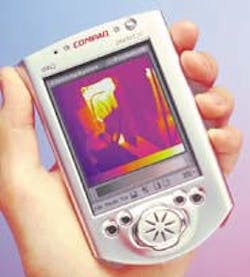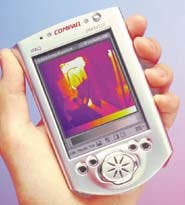Hand-held PDAs integrate imaging
As hand-held computers move toward commodity status, they are seriously being considered as useful machine-vision and image-processing devices. Last July, Braintech (North Vancouver, BC, Canada) introduced its eVisionFactory system that can transmit status information to hand-held devices such as Palm Pilots located up to 500 ft from the system (see Vision Systems Design, July 2001, p. 10).
This month, Electrophysics Corp. (Fairfield, NJ) launches ImagePAD, an image recorder, display, and camera-control product based on the Compaq Computer (Dallas, TX) iPAQ personal digital assistant (PDA). Its initial implementation is coordinated with the Raytheon Commercial Infrared (Dallas, TX) radiometric version of its PalmIR camera. The PalmIR 500 radiometer features an uncooled, 320 x 240-pixel focal-plane array that performs direct temperature measurements up to 300°C, stores 16-bit images, and uses a pushbutton user interface. It is available with the ImagePAD as an integrated-display, image-recording, and control accessory.
The PalmIR 500 5-Mbyte/s output is multiplexed to a proprietary interface card mounted inside the iPAQ's Compact Flash accessory sleeve. The interface card is connected to the iPAQ system bus and enables 30-frame/s viewing of uncompressed digital camera data. Snapshot 16-bit images can be recorded onto the iPAQ's Compact Flash memory card. The PalmIR radiometer uses NASA's fts file format originally designed for uncompressed images.
Images are downloaded by plugging the iPAQ into its cradle and using an ActiveSync function to download image files. Alternatively, the PCMCIA memory card with the image data can be removed and inserted into a host PC.
The iPAQ features the Intel 200-MHz Strong ARM 32-bit processor, 32 or 64 Mbytes of RAM, and a front-illuminated, reflective, 240 x 320-pixel TFT LCD display. Camera control is executed via a graphical user interface—a touchscreen on the PDA's liquid-crystal display—through the system's RS-232C communications port. Electrophysics used Microsoft's C++ development system to develop the software. The application runs under Windows CE, the same operating system used by the iPAQ Pocket PC.
ImagePAD is being offered to camera OEMs that need to add a portable, battery-powered, image-recorder/display/ controller for field applications. "Once we developed the real-time 16-bit camera interface, we realized that other camera developers could take advantage of the capability of the iPAQ," says Art Stout, vice president, sales and marketing, at Electrophysics. According to Stout, the company has begun discussions with other camera developers and hopes to develop a series of standard interfaces and provide custom software development services. "We know that over time, the cost of PDA devices will continue to fall, making this class of portable PCs the right choice for a growing number of specialty camera developers," he adds.

